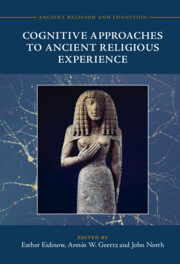Book contents
- Cognitive Approaches to Ancient Religious Experience
- Ancient Religion and Cognition
- Cognitive Approaches to Ancient Religious Experience
- Copyright page
- Contents
- Figures and Tables
- Contributors
- Abbreviations
- Funder Acknowledgement
- Introduction
- Part I Ritual
- Part II Representation
- Part III Gender
- Chapter 6 The Bacchants Are Silent
- Chapter 7 Who Is the Damiatrix?
- Part IV Materiality
- Part V Texts
- Index
- References
Chapter 7 - Who Is the Damiatrix?
Roman Women, the Political Negotiation of Psychotropic Experiences, and the Cults of Bona Dea
from Part III - Gender
Published online by Cambridge University Press: 28 July 2022
- Cognitive Approaches to Ancient Religious Experience
- Ancient Religion and Cognition
- Cognitive Approaches to Ancient Religious Experience
- Copyright page
- Contents
- Figures and Tables
- Contributors
- Abbreviations
- Funder Acknowledgement
- Introduction
- Part I Ritual
- Part II Representation
- Part III Gender
- Chapter 6 The Bacchants Are Silent
- Chapter 7 Who Is the Damiatrix?
- Part IV Materiality
- Part V Texts
- Index
- References
Summary
The present contribution offers a neurosociological and socio-cognitive re-analysis of the two festivities dedicated to the ancient Roman goddess known as Bona Dea, both managed and attended by women only. Additionally, the main variants of Bona Dea’s mythography are assessed as a violent reminder of gendered behavioural norms and as a coercive mate-guarding strategy supported by religious storytelling. The two festivities are assessed as different expressions of class stratification and socio-political negotiation within the Roman agnatic patriarchy. The patrician December festival is identified as a special agent ritual with distinctly imagistic features. The poorly known May celebration is tentatively reconstructed as a predominantly doctrinal, non-patrician special patient ritual, mainly attended by freedwomen, and led by a priestess known as the damiatrix. The supposedly orgiastic Greek roots of the cult are questioned on linguistic, historiographical, and archaeological grounds. The conclusions highlight the need to establish a cross-disciplinary cognitive historiography of sex and gender in antiquity to overcome the limitations behind the study of ancient women’s religious experiences.
- Type
- Chapter
- Information
- Cognitive Approaches to Ancient Religious Experience , pp. 167 - 190Publisher: Cambridge University PressPrint publication year: 2022

